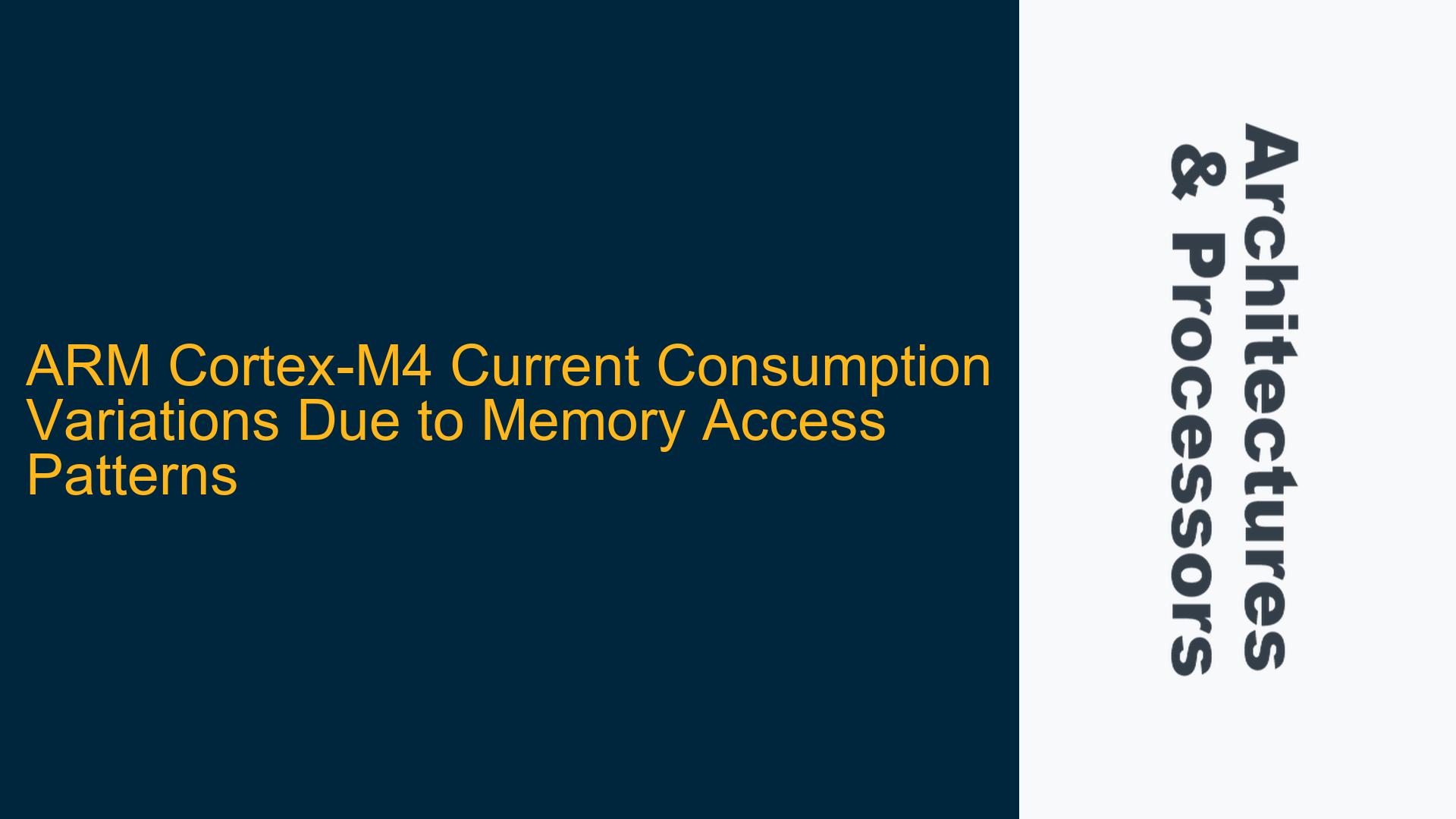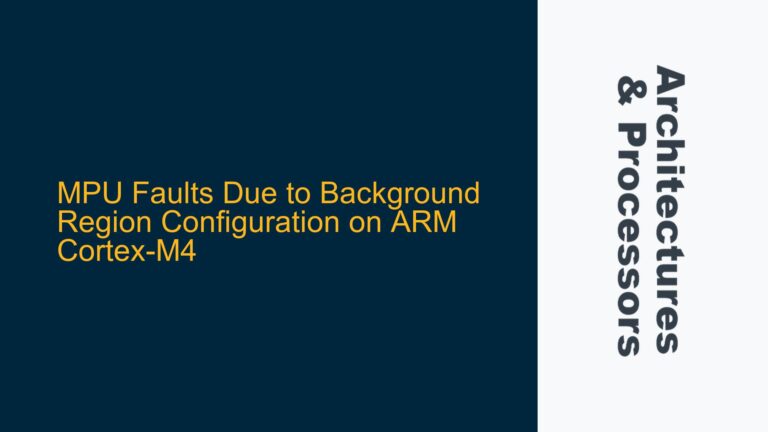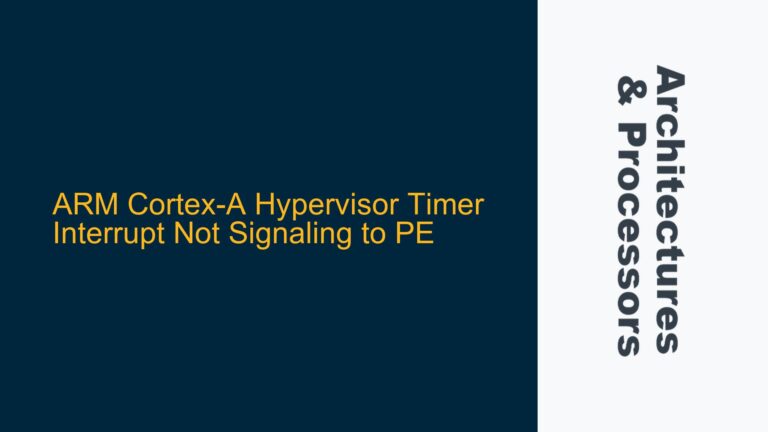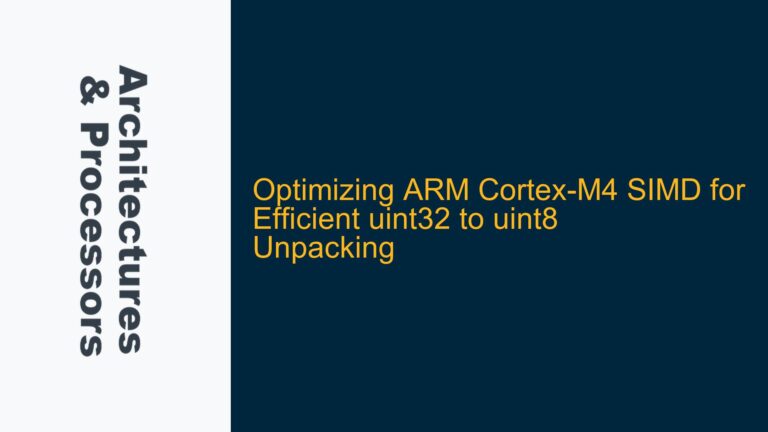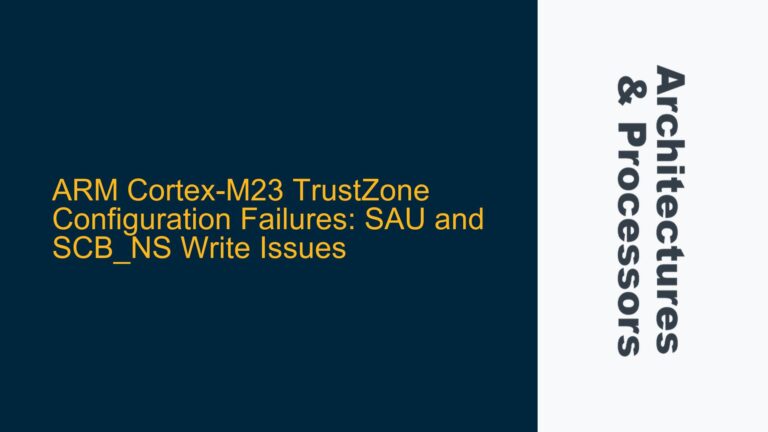Memory Access Alignment and Bus Transfer Efficiency in ARM Cortex-M4
The ARM Cortex-M4 processor, like many embedded microcontrollers, exhibits variations in current consumption and clock cycle counts based on memory access patterns. These variations are primarily influenced by the alignment of memory addresses, the underlying bus protocol (AHB Lite), and the activation of specific byte lanes during data transfers. Understanding these factors is critical for optimizing both power consumption and performance in embedded systems.
When accessing memory, the Cortex-M4’s bus interface breaks down unaligned transfers into multiple aligned transfers, as the AHB Lite protocol does not support unaligned transfers. This results in different numbers of bus transactions and varying levels of current consumption depending on the offset from an aligned address. For example, a 32-bit load instruction (LDR) from an aligned address (e.g., offset 0) requires a single 32-bit transfer, while the same instruction from an unaligned address (e.g., offset 1) may require multiple smaller transfers (8-bit or 16-bit). Each transfer activates specific byte lanes in the memory subsystem, which directly impacts power consumption.
The memory subsystem in the Cortex-M4 is organized into 32-bit wide rows, with each row containing four byte lanes. When a memory access occurs, the processor’s bus interface determines which byte lanes need to be activated based on the address alignment and transfer size. For example, a 32-bit transfer from an aligned address activates all four byte lanes, while an unaligned transfer may activate fewer lanes per transaction, depending on the address offset. This activation pattern directly influences the current consumption, as more active byte lanes result in higher power usage.
Additionally, the memory region being accessed (e.g., Flash vs. SRAM) also affects current consumption. Flash memory accesses typically consume less power than SRAM accesses because the Flash memory macro is optimized for lower power operation. However, when accessing SRAM, both the Flash memory macro and the SRAM macro may be active simultaneously, leading to higher current consumption. This is particularly evident in systems where instruction fetches and data accesses occur concurrently.
AHB Lite Protocol Constraints and Byte Lane Activation
The AHB Lite protocol, which governs the bus interface in the Cortex-M4, imposes strict alignment requirements for memory transfers. This protocol supports 32-bit, 16-bit, and 8-bit transfers but does not allow unaligned transfers. As a result, the processor’s bus interface must decompose unaligned 32-bit transfers into multiple aligned transfers, each of which activates specific byte lanes in the memory subsystem.
For example, consider a 32-bit load instruction (LDR R4, [R1, #0x1]) where the base address R1 is 0x00000000 and the offset is 0x1. This results in an unaligned address (0x00000001), which the bus interface breaks down into the following transfers:
- An 8-bit transfer to address
0x00000001, activating one byte lane. - A 16-bit transfer to address
0x00000002, activating two byte lanes. - An 8-bit transfer to address
0x00000004, activating one byte lane.
Each of these transfers consumes a different amount of power due to the varying number of active byte lanes. Similarly, a 32-bit load instruction with an offset of 0x2 (LDR R4, [R1, #0x2]) results in two 16-bit transfers, each activating two byte lanes. This explains why the current consumption and clock cycle counts vary with different offsets.
The repetition of current consumption patterns every four offsets (e.g., offset 4 behaving like offset 0) is due to the 32-bit alignment of the memory subsystem. When the offset reaches a multiple of 4, the address becomes aligned again, resulting in a single 32-bit transfer that activates all four byte lanes. This alignment resets the pattern of current consumption and clock cycle counts.
Optimizing Memory Access for Power and Performance
To minimize current consumption and improve performance in ARM Cortex-M4 systems, developers should prioritize aligned memory accesses. Aligned accesses reduce the number of bus transactions and limit the activation of unnecessary byte lanes, leading to lower power consumption and fewer clock cycles. Here are some strategies for achieving this:
-
Align Data Structures: Ensure that data structures in memory are aligned to 32-bit boundaries. This can be achieved using compiler directives or by manually padding structures to meet alignment requirements. For example, in C, the
__attribute__((aligned(4)))directive can be used to enforce 32-bit alignment. -
Use Appropriate Data Types: Choose data types that naturally align with the processor’s word size. For example, prefer
uint32_toveruint8_tfor variables that are frequently accessed, as this reduces the likelihood of unaligned accesses. -
Optimize Memory Layout: Arrange frequently accessed data in memory to minimize unaligned accesses. For example, place 32-bit variables at the beginning of structures or arrays to ensure alignment.
-
Leverage Compiler Optimizations: Enable compiler optimizations that promote aligned memory accesses. Most modern compilers provide options to optimize for alignment and reduce unaligned transfers.
-
Monitor Power Consumption: Use power profiling tools to identify memory access patterns that contribute to high current consumption. This can help pinpoint specific areas for optimization.
By understanding the relationship between memory access patterns, bus transfers, and current consumption, developers can design more efficient embedded systems. The Cortex-M4’s bus interface and memory subsystem provide a robust foundation for achieving both high performance and low power consumption, but careful attention to alignment and access patterns is essential for realizing these benefits.
Detailed Analysis of Current Consumption Variations
The variations in current consumption observed during memory accesses can be attributed to several factors, including the number of bus transactions, the activation of byte lanes, and the memory region being accessed. Below is a detailed breakdown of these factors:
Bus Transactions and Byte Lane Activation
When a memory access occurs, the Cortex-M4’s bus interface generates one or more bus transactions based on the address alignment and transfer size. Each transaction activates specific byte lanes in the memory subsystem, which directly impacts current consumption. The following table summarizes the bus transactions and byte lane activations for different offsets:
| Offset | Address | Bus Transactions | Active Byte Lanes | Current Consumption |
|---|---|---|---|---|
| 0 | 0x00000000 | 1 x 32-bit transfer | 4 | 2.60 mA |
| 1 | 0x00000001 | 1 x 8-bit, 1 x 16-bit, 1 x 8-bit transfer | 1, 2, 1 | 2.07 mA |
| 2 | 0x00000002 | 2 x 16-bit transfer | 2, 2 | 2.30 mA |
| 3 | 0x00000003 | 1 x 8-bit, 1 x 16-bit, 1 x 8-bit transfer | 1, 2, 1 | 2.08 mA |
| 4 | 0x00000004 | 1 x 32-bit transfer | 4 | 2.60 mA |
As shown in the table, the number of bus transactions and active byte lanes varies with the offset, leading to different levels of current consumption. The pattern repeats every four offsets due to the 32-bit alignment of the memory subsystem.
Memory Region Impact on Current Consumption
The memory region being accessed also plays a significant role in current consumption. Flash memory accesses typically consume less power than SRAM accesses because the Flash memory macro is optimized for lower power operation. However, when accessing SRAM, both the Flash memory macro and the SRAM macro may be active simultaneously, leading to higher current consumption. This is particularly evident in systems where instruction fetches and data accesses occur concurrently.
For example, consider the following current consumption measurements for Flash and SRAM accesses:
| Memory Region | Offset | Current Consumption |
|---|---|---|
| Flash | 0 | 2.60 mA |
| Flash | 1 | 2.07 mA |
| Flash | 2 | 2.30 mA |
| Flash | 3 | 2.08 mA |
| SRAM | 0 | 2.88 mA |
| SRAM | 1 | 2.30 mA |
| SRAM | 2 | 2.65 mA |
| SRAM | 3 | 2.29 mA |
As shown in the table, SRAM accesses generally consume more current than Flash accesses due to the simultaneous activation of both memory macros. This highlights the importance of considering memory region when optimizing for power consumption.
Practical Recommendations for Developers
To achieve optimal power and performance in ARM Cortex-M4 systems, developers should adopt the following practices:
-
Align Data Structures: Ensure that data structures are aligned to 32-bit boundaries to minimize unaligned accesses. This can be achieved using compiler directives or manual padding.
-
Use Appropriate Data Types: Prefer 32-bit data types for frequently accessed variables to reduce the likelihood of unaligned accesses.
-
Optimize Memory Layout: Arrange frequently accessed data in memory to minimize unaligned accesses. For example, place 32-bit variables at the beginning of structures or arrays.
-
Leverage Compiler Optimizations: Enable compiler optimizations that promote aligned memory accesses and reduce unaligned transfers.
-
Monitor Power Consumption: Use power profiling tools to identify memory access patterns that contribute to high current consumption and optimize accordingly.
By following these recommendations, developers can minimize current consumption and improve performance in ARM Cortex-M4 systems. Understanding the relationship between memory access patterns, bus transfers, and current consumption is essential for designing efficient embedded systems.
